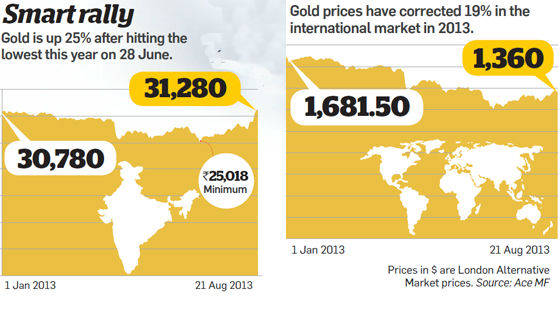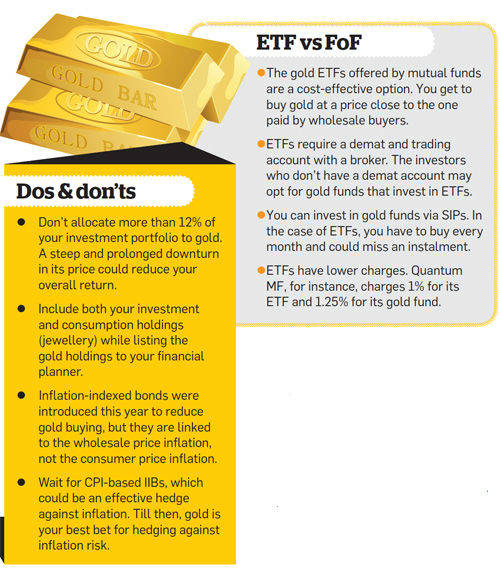

Latest articles on Life Insurance, Non-life Insurance, Mutual Funds, Bonds, Small Saving Schemes and Personal Finance to help you make well-informed money decisions.
The sharp depreciation in the rupee and the desperate measures taken by the Reserve Bank of India (RBI) to curtail its fall have ravaged NehaKohli’s investment portfolio. The equity and debt funds in the portfolio of this Delhi-based research associate have declined in value. However, there is some relief from gold, which has rallied smartly in these difficult times. "I was sceptical, but my financial planner persuaded me to invest in gold ETFs a few months ago," she says gratefully. Her investment in gold has appreciated nearly 15%.
Why has gold run up?

From this year’s low of Rs 25,018.50 per 10 gram on 28 June, gold rose sharply to Rs 31,280 on 21 August, an appreciation of more than 25% in less than two months. Several factors are responsible for this. The price of gold in India depends on two factors: the international price of gold in dollars, and the movement of the rupee vis-a-vis the dollar.
First, the international price of gold has bounced back from $1,203.25 per ounce on 28 June to $1,360 on 21 August. This happened because a lot of demand came in at the $1,200 level. The average, all-inclusive cost of production of gold is about $1,200. When the market price approaches this level, the buyers feel reassured that prices won’t fall further because the producers would start reducing the supply. The demand came from both central banks and traditional consumption centres, such as China and India. In India, for instance, the April-June consumption of 310 tonne was the highest in a quarter in the past 10 years.
Second, the rupee has depreciated sharply. When the rupee falls, gold, most of which is imported, becomes costlier for Indian buyers. The Indian currency, as is well known, is depreciating due to the country’s high current account deficit (CAD) and lack of investor confidence in the government’s ability to deal with the issues facing the economy.
Three, there has been some dilution in the US Fed’s stand on the tapering in quantitative easing (QE). After his first statement on 19 June caused outflows from the emerging market debt and currencies, Fed chairman Ben Bernanke tried to calm the markets through his testimony to the US Congress on 17 July. He said that it was too early to make a judgement whether bond purchases would be scaled back from September. His statement gave the markets a breather and the price of gold jumped, supported by physical demand.
Smart rally in gold
Four, the Indian government, which is keen on reducing CAD by curbing gold consumption, raised the custom duty on the yellow metal from 8% to 10%. This, too, contributed to the price rise in India.
Correction in international price
The year-to-date (till 21 August) price of gold is up a marginal 1.62% in India. The international price of gold, however, has fallen sharply, by 19.12% during the same period. So far, Indian investors have been protected from this carnage by the rupee’s depreciation, but why has gold taken such a beating in the international market? One point of view is that the recent decline is a mere correction in gold’s continuing bull run. Says Chirag Mehta, fund manager, commodities, Quantum Mutual Fund: "Such a correction is part of every bull run." He cites the example of 2008, when the gold’s fundamentals were strong, but it had still corrected about 30% because investors had sold gold to meet their margin requirements in the equity markets.
A similar correction had occurred during the 1970s bull run, when prices had risen considerably, then corrected by around 40%, only to rise again by 100%. A different point of view on gold’s decline is that its demand comes from three sources: investment, consumption, and official or central bank demand. Of the three, two have weakened. The consumption demand, which comes mainly from China and India, has remained steady in the past six to eight months. The demand from central banks has, however, fallen. Earlier, the emerging market central banks were aggressive buyers of gold as they wanted to diversify their reserves. Now that their currencies are under pressure, they are preserving their reserves and not using them to buy gold.
The investment demand, a major contributor to total demand, has also declined. This demand is due to two reasons. First, investors regard gold as a safe-haven bet that protects their portfolios in adverse economic conditions. Second, it is seen as a hedge against inflation. With the US economy recovering, the dollar strengthening, and interest rates in that country moving up, gold has lost its sheen as a safe avenue. So far, inflation in the developed world has also remained low. Says Vishal Dhawan, chief financial planner at Mumbai-based Plan Ahead Wealth Advisors: "That investment demand for gold has declined is evident since SPDR Gold Shares ETF, the world’s largest gold ETF, has witnessed outflows every month this year except in the last month."
Long-term outlook still strong
From this year’s peak of $1,692.50 per ounce on 22 January, gold fell to $1,203.25 on 28 June. Then it climbed again to around $1,360. This raises a question: are the prospects of gold still bright and will it continue to rally?
Do and dont’s - ETFs versus FoFs
Mehta of Quantum Mutual Fund is of the view that gold’s fundamentals remain strong. "The rationale for owning gold is the global deterioration of sovereign credit and a growing need to debase currencies to meet future obligations, whether it’s in the US, Europe or Japan," he says. In his opinion, the policy of socialising risk with monetary and fiscal policy has destroyed the balance sheets of the western world. He adds: "We are in a phase of experimental central banking, which is going to end badly due to the dislocations of capital it has caused through prolonged periods of negative interest rates. In the long term, such experimental central banking could cause severe problems, such as inflation." Hence, he says, allocation to gold remains essential.

What about the argument that with the rise in interest rates in the US, gold’s attractiveness has diminished? Mehta concedes that the metal does well when real interest rates are negative, which could be the reason many investors have sold gold. However, he counters it by saying, "A large quantum of liquidity has been infused into the system. If the US economy were to do well, the rate of inflation is likely to run ahead of the increase in rates, driving real interest rates into the negative territory again." Moreover, it is not yet established that the US economic recovery will sustain.
The number of people living on food stamps is at a record high. The labour participation rate has fallen significantly, which is why the unemployment rate has fallen, not because employment is picking up. The employment of part-time workers is at the highest level, reflecting lack of confidence among employers. Even the Eurozone debt crisis is far from over, with the peripheral nations unable to break out of the vicious cycle of austerity and slowing growth. Over the long term, the price of gold is driven by the level of confidence in the monetary system and the economy. With so many governments struggling with rising deficits and unsustainable debt, the case for investing in gold remains strong.
What should you do?
Retail investors should maintain a 8-12% allocation to gold in their portfolios. One reason is the challenge posed by inflation. Another is diversification. Gold has a negative correlation with the equity market. In 2008, when the Sensex had fallen by 52.48%, gold had risen by 25.95%. Gold has a low-to-neutral correlation with the bond market. Hence, it serves as a useful diversification tool in investors’ portfolios.
In situations where real interest rates turn negative, as has been the case for the past couple of years in India, gold tends to do well. In such situations, you may increase your exposure to 12%. The Indians have very few investments that can provide a hedge against the rupee’s depreciation. "Most of them don’t have adequate exposure to international funds. Now the central bank has imposed curbs on property purchases abroad," says Dhawan. Gold, he says, provides a partial hedge against the rupee’s depreciation. Having taken an 8-12% exposure to gold, rebalance your portfolio periodically, say, every six months. If the allocation falls below this level, buy more. If it rises above this, sell. Do this over a lifetime, and you will invest profitably in gold.